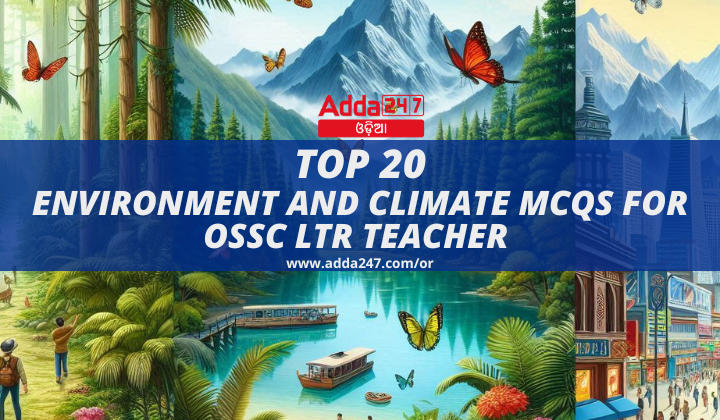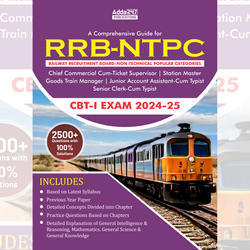Understanding environmental issues and climate change is essential for competitive exams, especially in today’s era of global climate concerns. This set of 20 MCQs focuses on climate-related policies, initiatives, and environmental challenges, which are essential topics for exams like OSSC LTR Teacher. Each question is crafted to test knowledge on critical strategies for combating climate change, as well as India’s specific responses to these pressing issues.
Top 20 Environment and Climate MCQs For OSSC LTR Teacher 31 October 2024
Q1. Which of the following is a method to remove carbon dioxide from the atmosphere and store it long-term?
- (a) Carbon Credit
- (b) Carbon Tax
- (c) Carbon Sequestration
- (d) Carbon Offset
S1. Ans: (c) Carbon Sequestration
Sol: Carbon sequestration involves capturing and storing CO₂ from the atmosphere, often in natural reservoirs like forests and oceans, or in geological formations, as a climate change mitigation technique.
Q2. What percentage of global greenhouse gas emissions is attributed to the transport sector?
- (a) 5%
- (b) 10%
- (c) 15%
- (d) 25%
S2. Ans: (d) 25%
Sol: The transport sector contributes roughly 25% of global GHG emissions, primarily from the burning of fossil fuels in cars, trucks, and airplanes, making it a significant focus for emission reduction strategies.
Q3. India’s Bureau of Energy Efficiency (BEE) was set up to promote:
- (a) Renewable energy adoption
- (b) Sustainable agriculture
- (c) Energy efficiency
- (d) Biodiversity conservation
S3. Ans: (c) Energy efficiency
Sol: The BEE was established to monitor and enhance energy efficiency across various sectors in India, reducing energy consumption and emissions.
Q4. Which natural phenomenon is a primary carbon sink?
- (a) Volcanic eruptions
- (b) Coral reefs
- (c) Oceans
- (d) Ozone layer
S4. Ans: (c) Oceans
Sol: Oceans are significant carbon sinks, absorbing about a quarter of CO₂ emissions, thus playing a crucial role in mitigating climate change.
Q5. The primary goal of the Kyoto Protocol is to:
- (a) Increase nuclear power
- (b) Regulate global trade
- (c) Reduce greenhouse gas emissions
- (d) Promote fossil fuel usage
S5. Ans: (c) Reduce greenhouse gas emissions
Sol: The Kyoto Protocol, an international treaty, aims to reduce greenhouse gases by setting emission reduction targets for industrialized countries.
Q6. Which organization is responsible for coordinating global climate action and negotiating treaties like the Paris Agreement?
- (a) UNCTAD
- (b) UNESCO
- (c) UNFCCC
- (d) WHO
S6. Ans: (c) UNFCCC
Sol: The United Nations Framework Convention on Climate Change (UNFCCC) leads global efforts on climate change and organizes events like the Conference of the Parties (COP) meetings.
Q7. Which mission under India’s National Action Plan on Climate Change aims to enhance forest cover?
- (a) National Water Mission
- (b) National Mission on Green India
- (c) National Solar Mission
- (d) National Mission for Sustainable Agriculture
S7. Ans: (b) National Mission on Green India
Sol: The Green India Mission focuses on increasing forest cover and ecosystem restoration to enhance carbon sequestration and protect biodiversity.
Q8. The term “carbon credit” refers to:
- (a) A tax imposed on carbon emissions
- (b) A permit to emit a specified amount of greenhouse gases
- (c) The reduction of taxes for renewable energy usage
- (d) Carbon emissions absorbed by forests
S8. Ans: (b) A permit to emit a specified amount of greenhouse gases
Sol: Carbon credits are permits allowing companies to emit a certain amount of CO₂, traded as a way to incentivize reducing emissions.
Q9. Which international conference is primarily associated with climate change policies and targets?
- (a) G7 Summit
- (b) COP
- (c) BRICS
- (d) ASEAN
S9. Ans: (b) COP
Sol: The Conference of the Parties (COP) brings nations together annually under the UNFCCC to discuss climate change policies, including the Paris Agreement.
Q10. The primary objective of the Paris Agreement is to:
- (a) Reduce nuclear power reliance
- (b) Increase fossil fuel production
- (c) Keep global warming well below 2°C
- (d) Double forest area globally
S10. Ans: (c) Keep global warming well below 2°C
Sol: The Paris Agreement aims to keep the increase in global average temperature below 2°C, with efforts to limit it to 1.5°C to mitigate severe climate impacts.
Q11. India’s National Hydrogen Mission promotes:
- (a) Fossil fuel extraction
- (b) Hydrogen as an alternative fuel
- (c) Deforestation practices
- (d) Industrial farming
S11. Ans: (b) Hydrogen as an alternative fuel
Sol: The mission supports the production and use of green hydrogen as a clean energy alternative to reduce carbon emissions.
Q12. Which energy source is the most significant contributor to global CO₂ emissions?
- (a) Wind
- (b) Solar
- (c) Coal
- (d) Geothermal
S12. Ans: (c) Coal
Sol: Coal combustion is a major contributor to global CO₂ emissions, especially in power generation, due to its high carbon content.
Q13. The “Loss and Damage Fund” discussed at COP28 aims to support:
- (a) Developed nations only
- (b) Countries vulnerable to climate change impacts
- (c) Industrialized regions
- (d) Private corporations
S13. Ans: (b) Countries vulnerable to climate change impacts
Sol: The fund supports nations facing severe climate impacts, helping them recover and adapt, especially least developed countries.
Q14. India’s National Water Mission primarily focuses on:
- (a) Urban water management
- (b) Conservation of water resources
- (c) Increasing hydropower capacity
- (d) Expanding oceanic research
S14. Ans: (b) Conservation of water resources
Sol: The mission aims to conserve water and promote efficient use across sectors to address water scarcity.
Q15. Which initiative is part of India’s National Action Plan on Climate Change for agricultural resilience?
- (a) National Green India Mission
- (b) National Mission on Sustainable Agriculture
- (c) National Solar Mission
- (d) National Mission on Strategic Knowledge
S15. Ans: (b) National Mission on Sustainable Agriculture
Sol: This mission promotes climate-resilient agricultural practices to mitigate the impacts of climate change on food production.
Q16. Which country holds the top position globally in installed renewable energy capacity as of 2024?
(a) India
(b) China
(c) United States
(d) Germany
S16. Ans: (b) China
Sol: China leads the world in installed renewable energy capacity, primarily due to its vast investments in solar, wind, and hydropower infrastructure. As part of its energy transition strategy, China has made significant strides in increasing renewable energy capacity to combat climate change and reduce its carbon footprint.
Q17. What is the primary greenhouse gas emitted from agricultural practices like livestock farming?
(a) Methane (CH₄)
(b) Carbon Dioxide (CO₂)
(c) Nitrous Oxide (N₂O)
(d) Sulfur Dioxide (SO₂)
S17. Ans: (a) Methane (CH₄)
Sol: Methane is a potent greenhouse gas primarily emitted through livestock farming due to enteric fermentation in ruminant animals. It has a higher warming potential than CO₂ and contributes significantly to global warming.
Q18. Which initiative was launched by India to promote the use of electric vehicles and reduce carbon emissions?
(a) National Green Hydrogen Mission
(b) National Mission for a Green India
(c) Faster Adoption and Manufacturing of Electric Vehicles (FAME)
(d) Clean India Mission
S18. Ans: (c) Faster Adoption and Manufacturing of Electric Vehicles (FAME)
Sol: The FAME scheme was launched to support the faster adoption and manufacturing of electric and hybrid vehicles. It aims to reduce carbon emissions from the transport sector and promote sustainable mobility solutions in India.
Q19. Which of the following gases is primarily responsible for the greenhouse effect and climate change?
(a) Argon
(b) Carbon Dioxide (CO₂)
(c) Helium
(d) Neon
S19. Ans: (b) Carbon Dioxide (CO₂)
Sol: Carbon Dioxide (CO₂) is the primary greenhouse gas responsible for the greenhouse effect, which leads to climate change. It is mainly released from fossil fuel combustion and deforestation, trapping heat in the atmosphere.
Q20. What is the significance of the “1.5°C target” in climate change discussions?
(a) It represents the threshold to avoid sea level rise.
(b) It is a target to limit global warming to 1.5°C above pre-industrial levels.
(c) It indicates the safe temperature for human habitation.
(d) It is a goal for reducing emissions by 1.5%.
S20. Ans: (b) It is a target to limit global warming to 1.5°C above pre-industrial levels.
Sol: The 1.5°C target, established under the Paris Agreement, aims to limit global temperature rise to prevent severe climate impacts, such as extreme weather events, sea level rise, and loss of biodiversity.














